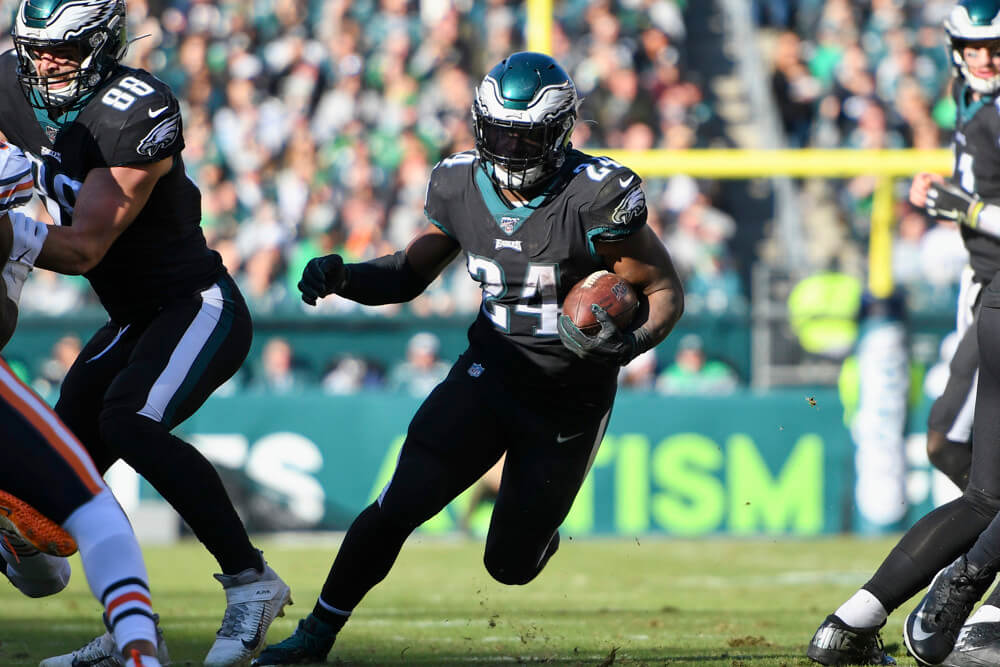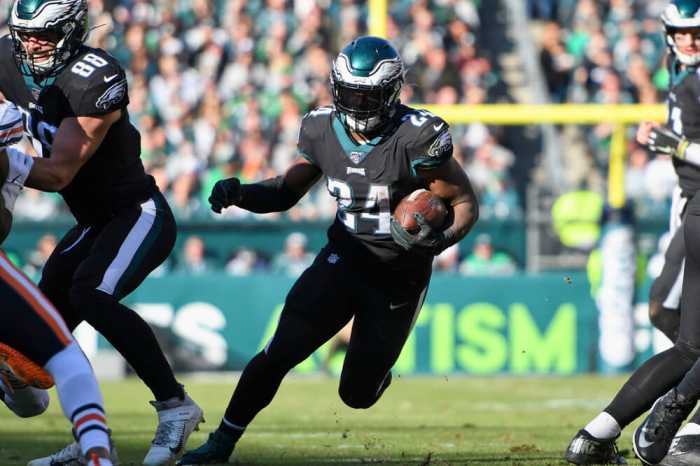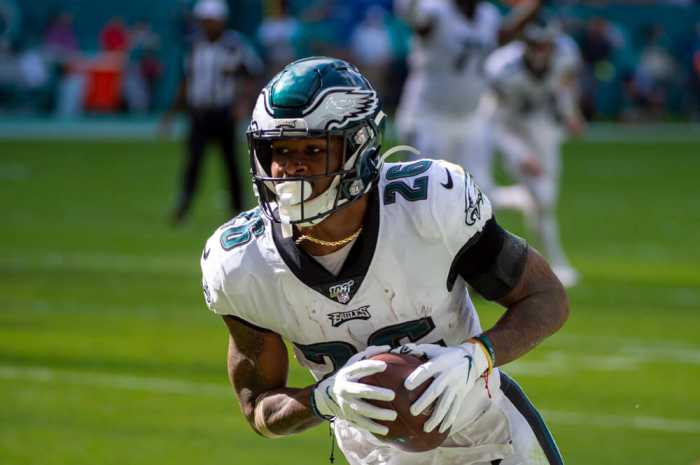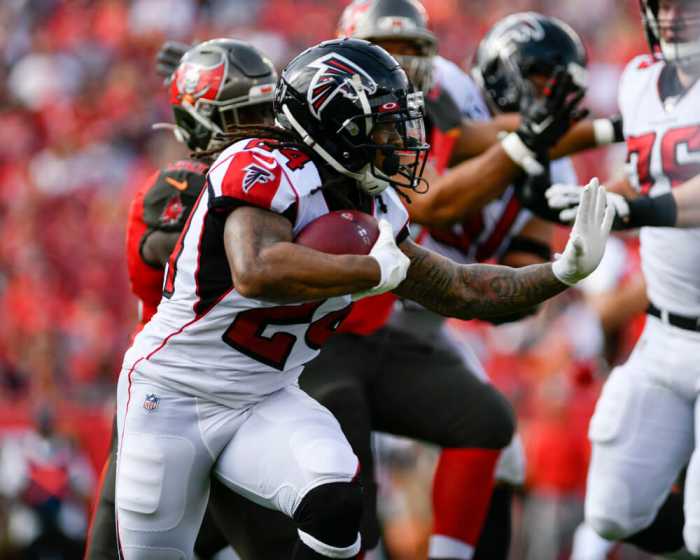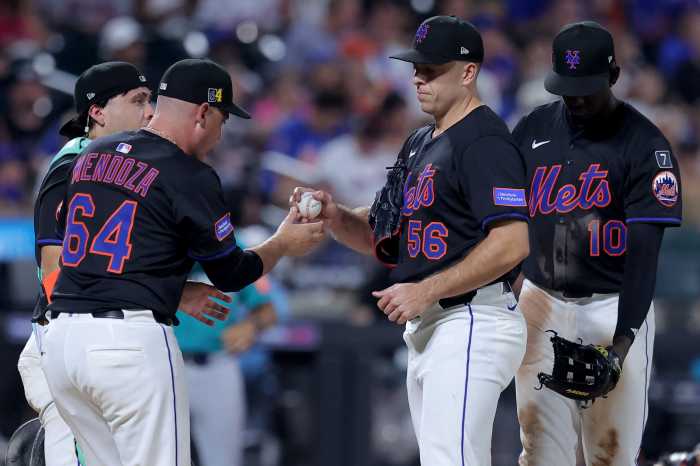The Philadelphia Eagles will enter Week 18 as the top rushing offense in the NFL. However, they haven’t had a single running back surpass 800 rushing yards on the season.
They’ve gotten contributions from Miles Sanders, Jordan Howard, Boston Scott, and Kenneth Gainwell using a running back by committee approach that differs from the traditional sense of the phrase.
The dominant play of the offensive line has been the true catalyst for the development of the dangerous rushing attack. Jalen Hurts has shown tremendous athleticism from the quarterback position and added a statistical boost as the team’s leading rusher with 784 yards on the ground in 15 games. Head coach Nick Sirianni has also committed heavily to the run with his play selection during the second half of the season.
These three key factors in the resurgence of the Eagles’ top-ranked running game have enabled the work of four running backs who have each added over 400 all-purpose yards this season.
Four Eagles Running Backs
The Eagles penciled in Sanders as their primary running back entering the 2021 season. The 2019 second-round draft pick is the most talented back on the roster. Four runs for 82, 74, 74, and 65 yards in his first two NFL seasons demonstrated the threat he poses as a home-run hitter that opposing defenses must account for. He leads all Eagles running backs with 754 rushing yards this season, thanks in large part to consecutive games with over 100 yards against the New York Jets and the Washington Football Team in December.
Jordan Howard made his way onto the active roster ahead of the Detroit Lions game in Week 8. He has revitalized his career by offering a change of pace from Sanders. He poses less of a threat to break longer runs, but he hits open holes hard. His straight-ahead style has meshed well with the strong run blocking along the offensive line. He has 406 rushing yards in seven games this season.
Boston Scott has proven he is capable of handling considerable workloads with 10 or more carries in six of 16 games this season. During Sunday’s win in Washington, he gave Hurts a good receiving option out of the backfield with four catches and added two touchdowns with impressive runs on a pair of 4th and Goal tries.
Rookie fifth-rounder Kenneth Gainwell began the season as the primary backup to Sanders. He showed good potential in the opening weeks of the season, especially as a receiver out of the backfield with 13 catches for 114 yards in Weeks 1-4.
Plug and Play
The contexts of the contributions of each running back are critical in analyzing the committee approach. The deployment has been severely affected by injuries, inconsistent balance in play-calling, and the emergence of a new team identity.
The Eagles averaged just 23.4 rushing attempts per game through Week 7, and Sirianni showed a tendency to abandon the run. Sanders saw 60% or more of the offensive snap counts in each of the Eagles first six games, but he only carried the ball 7.3 times on average in the final four games of that stretch. He suffered a leg injury in the first quarter in Week 7 against the Las Vegas Raiders.
His three-game absence began the committee’s bizarre shuffle. The injury pushed the Eagles to promote Howard from the practice squad and forced them to give Scott a bigger role. It came at the same time as Sirianni’s shift in offensive game planning.
The two backs helped the Eagles run 46 times for 236 yards against the Lions. The 44-6 win began a seven-game stretch in which the Eagles averaged 41.2 carries per game. Scott played four offensive snaps in Weeks 1-6 but suddenly found himself as a key factor in a revitalized Philadelphia offense.
Sanders joined the party and rushed for 94 yards against the New Orleans Saints in his return in Week 11. His heavy usage reduced Scott’s role and established a good complement with Howard. He reached a more effective level while playing under 60% of the offensive snaps in each of his last six games.
The rotation didn’t last long. Howard suffered a knee injury and missed the following two games. Sanders handled duties as the primary ball carrier and averaged 5.58 yards per carry (YPC) in Howard’s absence.
The Sanders/Howard complement proved lethal again in Week 14, but both backs suffered injuries against the New York Giants on Dec. 26. Sanders remains sidelined with a broken hand.
Sirianni has drifted away from using Gainwell in a major role. His biggest contributions on the ground during the second half of the season came during the respective fourth quarters of blowout wins against the Jets and Lions.
What does it all mean?
The success of the plug-and-play style didn’t translate statistically on Sunday in Washington.
Scott carried 14 times for 47 yards in the game when the Eagles finished with their lowest rushing total since Week 7 and their lowest YPC on the season. Howard carried 11 times for 26 yards. The 2.36 YPC was his lowest of the season by a wide margin.
The Eagles can’t interchangeably rotate running backs with no effect on the offense. They proved that Sunday with a rushing attack that paled in comparison to the spectacular efforts in the preceding weeks.
However, the trajectory of the Eagles rushing attack in 2021 indicates the importance of factors beyond the running back position that affect the running game in more significant ways than the backs themselves.
Bo Wulf of The Athletic accurately assessed the minimized running game after Sunday afternoon’s matchup as a product of an underwhelming effort from the offensive line.
“I thought the offensive line as a whole played its worst ganme in a while Sunday. Mailata struggled at times, Johnson committed two penalties and was a little less than perfect otherwise and Hurts faced more pressure than he has in a while. It’s hard to imagine the Eagles winning in two weeks if they cant rely on their bread-and-butter rushing attack.”
-Bo Wulf
He acknowledged the absence of Sanders and the potential nagging injury to Howard as additional factors but focused on the line, the foundational cause of Philadelphia’s ascension to the top-ranked rushing attack in the NFL.
Most NFL franchises value the run-blocking ability along the offensive line as a more important factor in the running game than the ball carrier himself, and very few teams allocate significant resources into one running back as a foundational building block for long-term success. The Eagles should serve as an example for NFL teams who evaluate the position in the future.
The shift in offensive game planning by Sirianni has also led to the breakout of the backs. The difference between the performance of Sanders at the beginning of the season with minimal opportunities and his performance since returning in Week 11 provides an example of how backs can benefit from a commitment to the running game and a favorable workload based on the contributions of an effective rotation.
The four running backs have performed impressively in 2021, and the health of Sanders and Howard is certainly noteworthy to the team moving forward. However, the ability of the team to plug and play with a four-man committee only reinforces the notion that running backs are actually a secondary factor in an effective rushing attack.
Photo by Andy Lewis/Icon Sportswire

